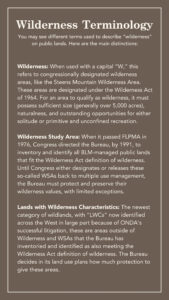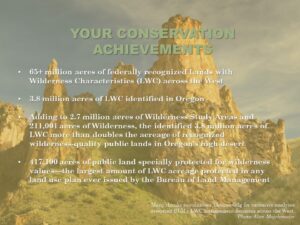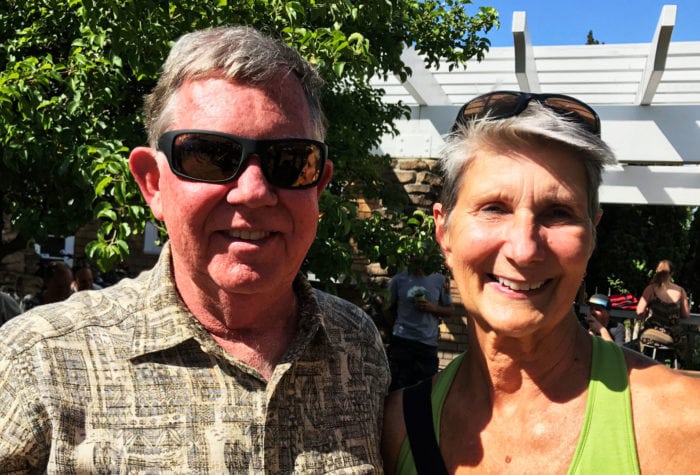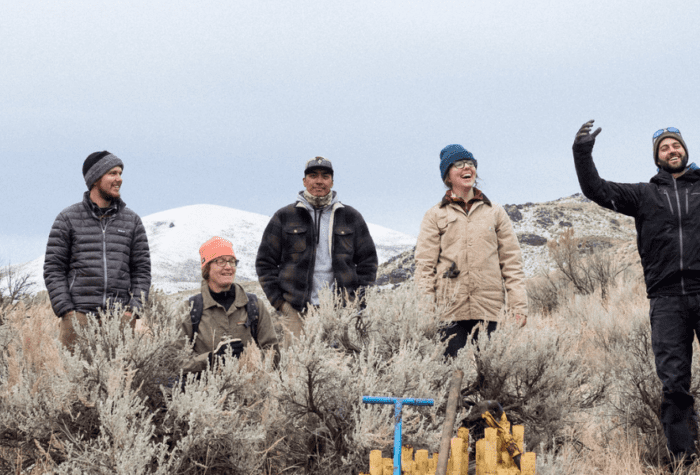Author: Mac Lacy | Published: March 4, 2024 | Category: Deep Dive
A deep dive into the history of the Southeastern Oregon Resource Management Plan and the future of Oregon’s Owyhee Canyonlands
In a momentous decision, the Bureau of Land Management (“BLM” or “Bureau”) has adopted a plan to protect more than 417,000 acres of wildlands in Oregon’s Owyhee Canyonlands. This achievement was more than two decades in the making, produced from a planning process driven by ONDA’s advocacy, wilderness inventory and insistence on science-based, legally compliant agency decision making.
The Southeastern Oregon Resource Management Plan (“SEORMP”) will guide management of 4.6 million acres of desert public lands in the Bureau’s Vale District for decades to come. In the final SEORMP, the BLM chose to prioritize preservation of wilderness values in so-called Lands with Wilderness Characteristics (“LWC”) across a critical swath of wildlands in this farthest corner of the state.
This is the largest amount of agency-protected LWC acreage provided in any land use plan ever issued by the Bureau. As detailed in the new plan, the agency will preserve wilderness values on these public lands first and foremost, restricting development, off-road vehicle travel, and other uses that could degrade these qualities. The newly protected wildlands include remote corners of the Sheepshead and Trout Creek mountains and vast expanses of native sagebrush that bestride the iconic Owyhee Wild and Scenic Rivers. These places provide intact habitat for hundreds of species, essential for maintaining biodiversity, mitigating climate change effects, and supporting sustainable economies.
The plan also closes all 4.6 million acres to off-road driving, with the exception of two small OHV play areas, near Vale, Oregon. It requires the Bureau to consider changes to livestock grazing management any time ecological standards are not being met. And it calls for the Bureau to consider other resources, including wilderness values, in deciding whether to end public lands grazing wherever a grazing permittee voluntarily relinquishes their grazing permit back to the agency.
This milestone decision was a long time coming. The planning process began in 1995, wound its way to and from federal court several times, and finally produced a plan that formally recognizes 1.3 million acres of wilderness-quality public lands identified by ONDA staff and volunteers — one-third of which are now prioritized for wilderness protection. The new plan will be a model for how to protect public wildlands across the West, building on historic precedents set in a multi-decade process and driven by ONDA’s strategic litigation and years of advocacy.
Decades of Advocacy
The Bureau’s land management authority is defined by the Federal Land Policy and Management Act (“FLPMA”), passed by Congress in 1976. FLPMA directs the Bureau to develop land use plans (also called resource management plans or “RMPs”) to establish which public lands are available for what types of uses — from permitted activities such as livestock grazing and mining, to preservation of values such as wildlife habitat and wilderness. To ensure it has adequate information to complete this task, FLPMA directs the Bureau to maintain accurate, up-to-date inventory information on public lands.
Wildlands are among the most important of public lands resources. These fragile and finite areas provide exceptional opportunities for solitude and quiet recreation. In Oregon’s high desert, they comprise some of the most biologically significant sagebrush landscapes remaining in North America. If managed to preserve wilderness values, these places can also sequester carbon and provide crucial habitat resiliency in the face of earth’s rapidly changing climate.
In 1964, Congress identified the conservation of wilderness lands as a “national priority” in the Wilderness Act. In that law, wilderness is defined “in contrast with those areas where man and his own works dominate the landscape.” For an area to qualify as wilderness, it must possess sufficient size (generally over 5,000 acres), naturalness, and outstanding opportunities for either solitude or primitive and unconfined recreation.
When it later passed FLPMA, Congress directed the Bureau, by 1991, to inventory and identify all BLM-managed public lands that fit the Wilderness Act definition of wilderness. Until Congress either designates or releases these so-called Wilderness Study Areas (“WSAs”), the Bureau must, with limited exceptions, protect and preserve their wilderness values. By 1987, the Bureau had identified 85 WSAs in eastern Oregon, spanning about 2.7 million acres of desert public lands.
ONDA formed at that same time. Concerned that the Bureau had overlooked much of Oregon’s high desert, ONDA’s founding members set out to conduct a wilderness review of their own. This ad hoc group of desert advocates hit the ground, hiking and mapping their way through eastern Oregon’s public lands, documenting the wilderness and other values of the high desert. Their “Sage Proposal” recommended five million acres for wilderness preservation in eastern Oregon — more than double the acres that the Bureau had identified as having wilderness character.
In 1992, ignoring ONDA’s proposal, the President submitted the Bureau’s wilderness recommendations to Congress. With limited exceptions, Congress has not yet acted upon those recommendations. (Congress designated the 170,200-acre Steens Mountain Wilderness Area in 2000, and the 29,301-acre Oregon Badlands Wilderness and 6,382-acre Spring Basin Wilderness in 2009.)
The Bureau then embarked on a series of land use plan updates. In 1995, the Bureau announced that it would prepare a land use plan — the SEORMP — to govern much of the agency’s Vale District in southeastern Oregon. As the planning process dragged into the 2000s, ONDA noted that the Bureau’s wilderness information was outdated and incomplete. ONDA urged the Bureau to update its baseline information on roadless areas and wilderness values before designing new management strategies for the region.
Preservation of wilderness values was an issue that resonated with the public; the majority of public commenters urged the Bureau to update its wilderness inventory information and protect wilderness-quality lands throughout Oregon’s high desert. The Bureau declined to do so and, through a controversial 2003 court settlement with the state of Utah, the George W. Bush administration decided that the Bureau no longer had any legal obligation, or even authority, to inventory, manage, or preserve wilderness values on public lands other than the original WSAs identified back in the 1980s.
ONDA responded by launching an independent inventory program, dubbed “Wilderness Research and Rescue.” In surveying public lands, ONDA staff and volunteers followed long-standing methods and documentation requirements set out in the Bureau’s own wilderness inventory handbook, even as that guidance was rescinded following the Utah settlement. ONDA collected and published information that local Bureau offices were barred — by Bush administration policy — from gathering and considering themselves.
ONDA submitted its inventory reports to Bureau offices throughout eastern Oregon and asked the agency to consider this information in its planning and management. Time and again, the Bureau opted not to do so and rejected nearly all of ONDA’s wilderness findings.
In 2003, ONDA filed the first of a series of lawsuits aimed at reversing the Bush administration’s “no-more-wilderness” policy. That case challenged the Bureau’s 2002 SEORMP decision where, implementing the Bush policy and Utah settlement, the agency did not consider wilderness values beyond the WSAs identified in the 1980s, when preparing its land use plan.
In 2008, ONDA won a landmark decision in the Ninth Circuit Court of Appeals. The court rejected the Bush policy, holding that the Bureau has the authority under FLPMA to manage public lands to preserve wilderness values and, therefore, the duty, when it prepares a land use plan, to consider (1) whether such lands exist in a planning area and, if so, (2) how to manage those values as part of the agency’s broad “multiple use” mission.
That unprecedented court decision led to a settlement agreement, in 2010, by which the Bureau agreed to update its wilderness inventory information and amend the SEORMP to reconsider wilderness character, travel management and livestock grazing issues. The settlement also applied to the Lakeview RMP, approved under similarly unlawful terms in 2005, and which guides management of about 3.2 million acres of public lands in the Greater Hart-Sheldon.
The settlement also provided crucial interim protections for more than three million acres of public-identified wilderness areas across the two planning areas. Indeed, those protections remain in place to this day on 1.7 million acres of wildlands in the Lakeview planning area, where the Bureau is still working on its plan amendment.
Importantly, the litigation led the Department of the Interior to once again recognize the Bureau’s wilderness management authority under FLPMA. In 2012, the Obama administration issued new manuals guiding wilderness inventory review and land management. For the first time in more than a decade, local Bureau offices once again had formal wilderness guidance in place, allowing them to consider wilderness just like any other resource or value in public lands planning and management. In renewing those manuals in 2021, the Trump administration reaffirmed the Bureau’s commitment to managing wilderness values on western public lands.
Over the next few years, pursuant to the ONDA settlement, the Bureau re-inventoried about 7.8 million acres of public lands in the Owyhee Canyonlands and Greater Hart-Sheldon. In the SEORMP area, the Bureau identified 1.3 million acres of LWC in 82 separate roadless areas. In the Lakeview RMP area, it identified 1.7 million acres of LWC in 111 areas. The Bureau also began reviewing ONDA’s wilderness reports for other areas, like Steens Mountain and the John Day River basin, documenting new LWC units throughout eastern Oregon.
Finally! The BLM had formally recognized wilderness values on millions of acres of public lands that ONDA had been advocating to protect since the 1980s.
The New Plan
But would the Bureau actually protect the millions of acres of LWCs it had identified in Oregon?
Under pressure from the Trump administration, the Bureau, in 2019, proposed to protect none of the LWCs it had identified in the ongoing SEORMP amendment process. It also declined to adjust off-road vehicle use or livestock grazing. In other words, the agency proposed to re-adopt the same plan the Ninth Circuit had deemed illegal a decade earlier. The Trump administration even wholly rejected the Bureau’s own, multi-stakeholder advisory council’s common-sense recommendation to balance grazing and other land uses with wilderness preservation in ecologically important LWCs. ONDA laid bare the many flaws of the Bureau’s tainted 2019 proposal in a powerful, 148-page letter submitted later that year.
In 2021, the Biden administration directed the Bureau to further review and adjust its final proposal for the SEORMP. Now, after more than two years of additional analysis, the Bureau has finally adopted its SEORMP plan amendment. The new plan—
- Protects wilderness values on 417,190 acres of public lands in 33 separate LWCs. These areas are now excluded from major rights-of-way, commercial energy projects, and certain mining activities. Another 882,000 acres in 43 separate roadless areas will still be classified as LWC and recognized by the Bureau as part of the environmental baseline for projects and land management going forward.
- Limits cross-country motorized use to two OHV play areas, near Vale, Oregon, that comprise 40,000 of the planning area’s 4.6 million acres. This means 99.9% of the SEORMP planning area — including all 33 of the protected LWC areas — is either closed to OHVs or limited to existing routes. This will help preserve some of the most biologically intact and unfragmented sagebrush habitat in the West.
- Calls for the Bureau to ensure permitted livestock grazing does not damage wilderness and habitat values. This includes: (1) making changes to grazing management any time a grazing allotment is not meeting ecological standards; (2) not increasing grazing where it could cause negative impacts to other resources; and (3) considering compatibility with wilderness and other values — including whether grazing should be discontinued — any time a rancher decides to voluntarily relinquish a grazing permit.
The plan will now govern the Bureau’s management of these public lands for decades to come; a robust new public process would be required to make any changes to these protections. Most importantly, the Bureau decision provides an outstanding foundation for even more wildlands conservation through our Owyhee Canyonlands campaign.
Groundbreaking Accomplishment
The Bureau’s decision builds on ONDA’s years of precedential litigation that not only benefited southeastern Oregon, but also led to the Bureau identifying another 25 million acres of LWC on public lands across the West (not including more than 60 million additional acres of LWC in Alaska). In Oregon, the 3.8 million acres of LWC newly identified in the last 15 years since our success in court more than doubles the acres of recognized wilderness-value public lands in Oregon’s high desert — adding to the 2.7 million acres of WSA identified by the Bureau in the 1980s and 200,000+ acres of congressionally designated Wilderness on Steens Mountain, Badlands, and Spring Basin.

Meanwhile, ONDA’s leading-edge wilderness inventory program, honed through decades of ground-based surveys and state-of-the-art GIS analyses, not only laid the foundation for our success in court, but also set the stage for conservation organizations around the West to form their own programs to inventory and advocate for wilderness preservation in other states.
With the Vale District’s SEORMP update now completed, you can be sure that ONDA will do everything we can to ensure a similar result on the Lakeview District, which contains millions of acres of its own remarkable landscapes — including vast sagebrush seas like Christmas Valley and Beatys Butte, hemispherically critical bird stopovers like Lake Abert and Summer Lake, and iconic basin and range wildlands that characterize the areas around Hart Mountain and Warner Basin.

